Battle of Saipan order of battle
On 15 June 1944, United States Marine and Army forces landed on the southwest coast of the island of Saipan in the central Marianas chain. The invasion of Saipan was part of Operation Forager, an effort to recapture the entire Marianas chain from the Empire of Japan.

The island had been a Japanese possession since it was captured by the Imperial Japanese Army during World War I. As military conflict with the United States became increasingly likely during the 1930s, Japan expended great effort in fortifying Saipan. In mid-1944, nearly 30,000 troops were based on the island, almost double the estimates of US intelligence.[1]
US forces declared Saipan secure on 9 July 1944.
United States
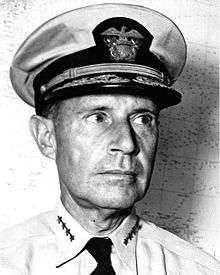

Naval forces
U.S. Fifth Fleet[2]
Admiral Raymond A. Spruance in heavy cruiser Indianapolis
Joint Expeditionary Force (Task Force 51)
Vice Admiral Richmond Kelly Turner in amphibious command ship Rocky Mount
- Northern Attack Force (Task Force 52 – Saipan and Tinian)
- Vice Admiral Turner
- Northern Attack Force (Task Force 52 – Saipan and Tinian)
- Southern Attack Force (Task Force 53 – Guam)
- Vice Admiral Richard L. Conolly in amphibious command ship Appalachian
- Southern Attack Force (Task Force 53 – Guam)
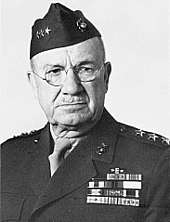
Ground forces
Expeditionary Troops (Task Force 56)
- Commanding General: Lt. Gen. Holland M. "Howlin' Mad" Smith[lower-alpha 1]
- Chief of Staff: Brig. Gen. Graves B. Erskine[lower-alpha 2]
- Personnel Officer (G-1): Lt. Col. Albert F. Metze
- Intelligence Officer (G-2): Col. St. Julien R. Marshall
- Operations Officer (G-3): Col. John C. McQueen
- Logistics Officer (G-4): Col. Raymond E. Knapp
- Plans Officer (G-5): Col. Joseph T. Smith
- Northern Troops and Landing Force (Task Group 56.1 – Tinian and Saipan)
- Consisting of V Amphibious Corps
- Southern Troops and Landing Force (Task Group 56.2 – Guam)
- Consisting of III Amphibious Corps
- Chief of Staff: Brig. Gen. Graves B. Erskine[lower-alpha 2]
V Amphibious Corps
- Commanding General (thru 12 Jul): Lt. Gen. Holland M. Smith[lower-alpha 3]
- Commanding General (after 12 Jul): Maj. Gen. Harry Schmidt
- Chief of Staff: Brig. Gen. Graves B. Erskine
- XXIV Corps Artillery (Brig. Gen. Arthur M. Harper)
- 1st Provisional Gun Group
- 225th Field Artillery Howitzer Group
- XXIV Corps Artillery (Brig. Gen. Arthur M. Harper)

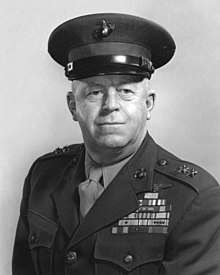
Northern landing area (Red and Green beaches):
![]()
- Commanding General: Maj. Gen. Thomas E. Watson
- Assistant Division Commander: Brig. Gen. Merritt A. Edson
- 2nd Marine Regiment
- Commanding Officer: Col. Walter J. Stuart
- Executive Officer: Lt. Col. John H. Griebel
- 1st Battalion, 2nd Marines (Lt. Col. Wood B. Kyle)
- 2nd Battalion, 2nd Marines (Lt. Col. Richard C. Nutting)
- 3rd Battalion, 2nd Marines (Lt. Col. Arnold F. Johnston)
- 6th Marine Regiment
- Commanding Officer: Col. James P. Riseley
- Executive Officer: Lt. Col. Kenneth F. McLeod
- 1st Battalion, 6th Marines (Lt. Col. William K. Jones)
- 2nd Battalion, 6th Marines (Lt. Col. Raymond L. Murray)
- 3rd Battalion, 6th Marines (Lt. Col. John W. Easley)
- 8th Marine Regiment
- Commanding Officer: Col. Clarence R. Wallace
- Executive Officer: Lt. Col. Jack P. Juhan
- 1st Battalion, 8th Marines (Lt. Col. Lawrence C. Hays Jr.)
- 2nd Battalion, 8th Marines (Lt. Col. Henry P. Crowe)
- 3rd Battalion, 8th Marines (Lt. Col. John C. Miller Jr.)
- 10th Marine Regiment (Artillery)
- Commanding Officer: Col. Raphael Griffin
- Executive Officer: Lt. Col. Ralph E. Forsyth
- 1st Battalion, 10th Marines (Lt. Col. Presley M. Rixey)
- 2nd Battalion, 10th Marines (Lt. Col. George R. E. Shell)
- 3rd Battalion, 10th Marines (Maj. William L. Crouch)
- 4th Battalion, 10th Marines (Lt. Col. Kenneth A. Jorgensen)
- 18th Marine Regiment (Engineer)
- Commanding Officer: Lt. Col. Ewart S. Laue
- 1st Battalion, 18th Marines (Lt. Col. August L. Vogt)
- 2nd Battalion, 18th Marines (Lt. Col. Chester J. Salazar)
- Attached units
- 1st Battalion, 29th Marine Regiment (Lt. Col. Guy E. Tannyhill; Lt. Col. Rathvon M. Tompkins; Lt. Col. Jack P. Juhan)[5]
- 715th Amphibian Tractor Battalion (Army)
- 2nd Marine Regiment
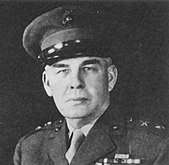

Southern landing area (Blue and Yellow beaches):
![]()
- Commanding General (thru 12 Jul): Maj. Gen. Maj. Gen. Harry Schmidt[lower-alpha 4]
- Commanding General (after 12 Jul): Maj. Gen. Clifton B. Cates
- Assistant Division Commander: Brig. Gen. Samuel C. Cumming
- 23rd Marine Regiment
- Commanding Officer: Col. Louis R. Jones
- Executive Officer: Lt. Col. John R. Lanigan
- 1st Battalion, 23rd Marines (Lt. Col. Ralph Haas)
- 2nd Battalion, 23rd Marines (Lt. Col. Edward J. Dillon)
- 3rd Battalion, 23rd Marines (Maj. John J. Cosgrove)
- 24th Marine Regiment
- Commanding Officer: Col. Franklin A. Hart
- Executive Officer: Lt. Col. Austin R. Brunelli
- 1st Battalion, 24th Marines (Lt. Col. Robert N. Fricke)
- 2nd Battalion, 24th Marines (Lt. Col. Richard Rothwell)
- 3rd Battalion, 24th Marines (Lt. Col. Otto Lessing)
- 25th Marine Regiment
- Commanding Officer: Col. Merton J. Batchelder
- Executive Officer: Lt. Col. Clarence J. O'Donnell
- 1st Battalion, 25th Marines (Lt. Col. Hollis U. Mustain)
- 2nd Battalion, 25th Marines (Lt. Col. Lewis C. Hudson)
- 3rd Battalion, 25th Marines (Lt. Col. Justice M. Chambers)
- 14th Marine Regiment (Artillery)
- Commanding Officer: Col. Louis G. DeHaven
- Executive Officer: Lt. Col. Randall M. Victory
- 1st Battalion, 14th Marines (Lt. Col. Harry J. Zimmer)
- 2nd Battalion, 14th Marines (Lt. Col. George B. Wilson Jr.)
- 3rd Battalion, 14th Marines (Maj. Robert E. MacFarlane)
- 4th Battalion, 14th Marines (Lt. Col. Carl A. Youngdale)
- 20th Marine Regiment (Engineer)
- Commanding Officer: Lt. Col. Nelson K. Brown
- Executive Officer: Capt. William M. Anderson
- 1st Battalion, 20th Marines (Maj. Richard G. Ruby)
- 2nd Battalion, 20th Marines (Maj. John H. Partridge)
- Attached units
- 708th Amphibian Tank Battalion (Army)
- 773rd Amphibian Tractor Battalion (Army)
- 534th Amphibian Tractor Battalion (Army)
- 23rd Marine Regiment
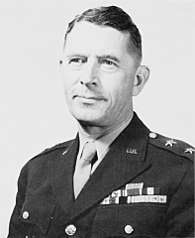
Landed Blue beaches D+1:
![]()
- Commanding General (thru 24 Jun): Maj. Gen. Ralph C. Smith[lower-alpha 5]
- Commanding General (24 Jun thru 28 Jun): Maj. Gen. Sanderford Jarman
- Commanding General (after 28 Jun): Maj. Gen. George W. Griner
- Infantry
- 105th Infantry Regiment
- 106th Infantry Regiment
- 165th Infantry Regiment
- Artillery
- 104th Field Artillery Battalion
- 105th Field Artillery Battalion
- 106th Field Artillery Battalion
- 249th Field Artillery Battalion
- Armor
- 762nd Tank Battalion
- 766th Tank Battalion
- Engineer
- 102nd Engineer Combat Battalion
- 502nd Engineer Combat Battalion
- Navy
- Infantry
Japan


Central Pacific Area Fleet HQ[7]
- Commanding officer: Vice Adm. Chūichi Nagumo (self-inflicted gunshot 6 July)
- Chief of staff: Rear Adm. Hideo Yano (seppuku 7 July)
- Commanding general: Lt. Gen. Hideyoshi Obata (on inspection tour of Guam during battle; seppuku there 11 August)
- 14th Air Fleet
Defenses of Saipan
- Commanding general: Lt. Gen. Saito Yoshitsugu (seppuku 7 July)
- Approx. 25,500 army and 6,200 navy personnel
- 43rd Division
- 118th Infantry Regiment
- 135th Infantry Regiment
- 136th Infantry Regiment
- Divisional support
- 47th Independent Mixed Brigade
- 316th Independent Infantry Battalion
- 317th Independent Infantry Battalion
- 318th Independent Infantry Battalion
- Other units
- 3rd Independent Mountain Artillery Regiment
- 9th Tank Regiment (of 1st Tank Division)
- 3rd Battalion, 9th Independent Mixed Regiment
- 1st Battalion, 18th Infantry Regiment
- 25th Antiaircraft Artillery Regiment
- 7th Independent Engineer Battalion
- 14th Independent Mortar Battalion
- 17th Independent Mortar Battalion
- Miscellaneous straggler units
- 43rd Division
Notes
- Generated so much ill will between the armed services in the Pacific Theater that he had to be relieved of command in July 1945.[3]
- Commanded 3rd Marine Division on Iwo Jima.
- Assigned to command of Fleet Marine Force, Pacific, an umbrella command of all Marine Corps forces in the Pacific Theater.[4]
- Took command of V Amphibious Corps upon the promotion of Lt. Gen. Smith to head of FMF.[6]
- Relieved of command and expelled from the island by Lt. Gen. Holland Smith for allowing his troops to fall behind the Marine Corps advance up the island.
References
- Rottman, p. 42
- Rottman, p. 35
- Rottman, p. 31
- Rottman, p. 28
- Johnston, Goldberg
- Rottman, p. 28
- Rottman, p. 91
Bibliography
- Goldberg, Harold J. (2007). D-Day in the Pacific: The Battle of Saipan. Indiana University Press. ISBN 0-25334-869-2.
- Johnston, Richard W. (1987). Follow Me: The Story of the Second Marine Division in World War II. Battery Press. ISBN 0-89839-099-0.
- Morison, Samuel Eliot (1953). New Guinea and the Marianas, March 1944 – August 1944. History of United States Naval Operations in World War II. VIII. Boston: Little, Brown and Co. LCCN 53-7298.
- Rottman, Gordon; Howard Gerrard (2004). Saipan & Tinian 1944: Piercing the Japanese Empire. Oxford: Osprey Publishing. ISBN 1-84176-804-9.